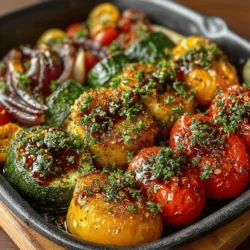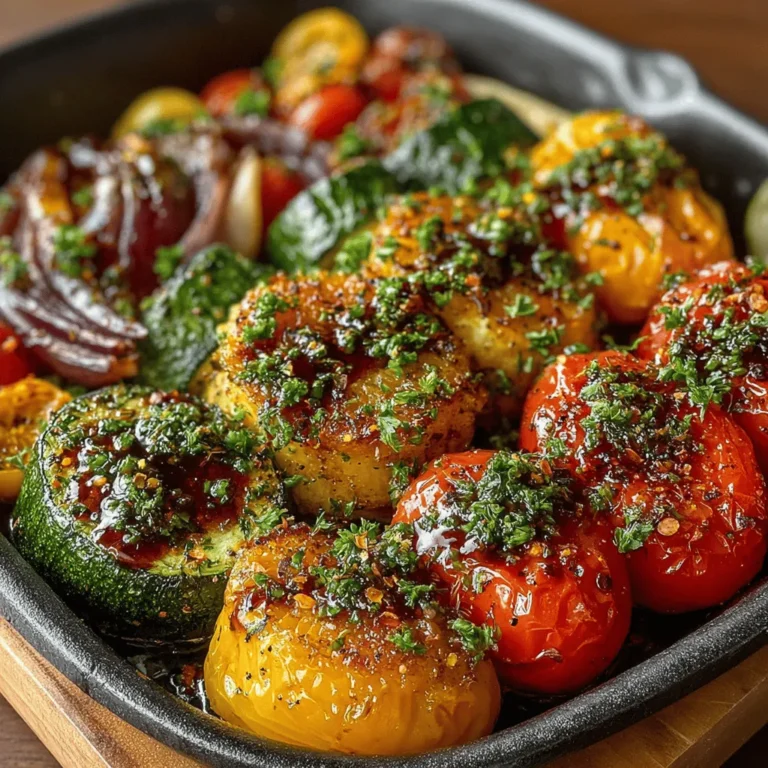Baked Balsamic Bliss: An Introduction to a Flavorful Delight
In the realm of culinary creations, few dishes boast the perfect balance of simplicity and flavor quite like Baked Balsamic Bliss. This delightful recipe showcases the harmony of fresh vegetables harmonized with a rich balsamic marinade, making it an exceptional addition to any meal. The beauty of Baked Balsamic Bliss lies in its ease of preparation, coupled with the vibrant and nutritious elements it presents. Imagine perfectly baked vegetables, infused with the tangy sweetness of balsamic vinegar, aromatic herbs, and a hint of honey—this dish is not only a feast for the palate but also a visual treat.
The allure of Baked Balsamic Bliss extends beyond its taste; it also provides numerous health benefits, making it a go-to option for health-conscious eaters and food enthusiasts alike. This dish is versatile enough to complement a variety of main courses, serve as a hearty side, or even stand alone as a light vegetarian meal. In this article, we will delve into the ingredients that make this recipe shine, guide you through the step-by-step preparation process, and explore the culinary benefits of each component.
Understanding the Ingredients
At the heart of Baked Balsamic Bliss lies a carefully chosen selection of ingredients that contribute to its unique taste and health benefits. Let’s explore each key component to better understand how they work together to create this delightful dish.
Exploration of Balsamic Vinegar
Balsamic vinegar, a staple in Mediterranean cuisine, originated in Italy and is renowned for its complex flavor profile. Traditional balsamic vinegar is made from freshly crushed grape juice, which is then cooked down and aged in wooden barrels, resulting in a rich, syrupy condiment that is both tangy and sweet. There are two main types of balsamic vinegar: traditional and commercial. Traditional balsamic vinegar is aged for a minimum of 12 years and is characterized by its thick consistency and intense flavor, while commercial varieties are often produced more quickly and may lack the depth of flavor.
In addition to its distinctive taste, balsamic vinegar offers various health benefits. It is low in calories and contains antioxidants that can help combat oxidative stress in the body. Incorporating balsamic vinegar into your meals not only enhances flavor but also contributes to a healthier diet.
Role of Extra Virgin Olive Oil
Another essential ingredient in Baked Balsamic Bliss is extra virgin olive oil, known for its exceptional flavor and health-promoting properties. This oil is derived from the first pressing of olives, making it the highest quality olive oil available. Rich in monounsaturated fats, extra virgin olive oil is celebrated for its heart-healthy benefits, including reducing inflammation and lowering the risk of chronic diseases.
In this recipe, extra virgin olive oil acts as a medium for the balsamic vinegar and honey, helping to create a luscious marinade that coats the vegetables evenly. Its rich, fruity flavor enhances the overall taste of the dish, adding a depth that complements the natural sweetness of the vegetables.
Honey as a Natural Sweetener
To achieve the perfect balance of flavors in Baked Balsamic Bliss, honey plays a pivotal role. This natural sweetener not only adds a touch of sweetness to the dish but also enhances the overall flavor profile. Honey has been used in culinary applications for centuries, praised for its unique taste and numerous health benefits.
Rich in antioxidants, honey supports the immune system and offers anti-inflammatory properties. Additionally, it serves as a natural energy booster, making it an excellent choice for those seeking a healthier alternative to refined sugars. In this recipe, the honey works in harmony with balsamic vinegar, balancing the tanginess with its sweetness and creating a truly delightful marinade.
Herbs and Spices: Fresh vs. Dried
The aromatic herbs used in Baked Balsamic Bliss elevate the dish, infusing it with fragrant notes that complement the vegetables beautifully. While both fresh and dried herbs have their place in cooking, fresh rosemary and thyme are particularly recommended for this recipe due to their vibrant flavor and aroma.
Fresh herbs not only provide a more intense flavor but also offer additional health benefits, including essential vitamins and minerals. Rosemary, for example, is rich in antioxidants and has been linked to improved digestion and memory. Thyme is known for its antibacterial properties and can support respiratory health. By using fresh herbs in Baked Balsamic Bliss, you enhance the dish’s overall flavor and nutritional value.
Vegetable Selection
One of the most appealing aspects of Baked Balsamic Bliss is its versatility when it comes to vegetable selection. This recipe allows you to experiment with a variety of vegetables, making it adaptable to personal preferences and seasonal availability. Common choices include eggplant, zucchini, bell peppers, and cherry tomatoes, but feel free to get creative with your selections.
When selecting vegetables, consider their seasonal peak for the best flavor and freshness. For example, summer is the perfect time to enjoy vibrant tomatoes and zucchinis, while fall brings hearty root vegetables like carrots and sweet potatoes. Each vegetable contributes its unique texture and taste to the dish, creating a delightful medley that enhances the overall experience.
Step-by-Step Preparation Guide
Now that we’ve explored the ingredients that make Baked Balsamic Bliss a flavorful sensation, let’s walk through the initial steps of preparing this delicious dish.
Preheating the Oven
The first step in creating Baked Balsamic Bliss is to preheat your oven. Preheating is essential as it sets the stage for even cooking and ensures that the vegetables roast to perfection. A well-preheated oven allows the vegetables to caramelize, enhancing their natural sweetness and creating a delightful texture. Aim to preheat your oven to 400°F (200°C), which is the ideal temperature for roasting vegetables.
Creating the Marinade
While the oven is heating up, it’s time to prepare the marinade that will infuse the vegetables with flavor. In a mixing bowl, combine balsamic vinegar, extra virgin olive oil, honey, and your choice of herbs. Whisk the ingredients together until well combined, ensuring that the honey fully dissolves into the mixture. Achieving a smooth consistency is crucial for even flavor distribution across the vegetables. The marinade should be tangy, sweet, and aromatic, setting the perfect foundation for your dish.
Preparing the Baking Dish
To ensure a seamless cooking experience, it’s important to prepare your baking dish properly. Lightly grease the dish with a small amount of extra virgin olive oil or non-stick cooking spray. This step prevents the vegetables from sticking and makes serving a breeze. A well-prepared baking dish will allow for easy removal of the roasted vegetables, keeping them intact and aesthetically pleasing.
Incorporating Spices for Enhanced Flavor
For those who enjoy a bit of heat, consider incorporating red pepper flakes into the marinade. This optional addition elevates the flavor profile, adding a subtle kick that complements the sweetness of the balsamic vinegar and honey. Adjust the amount of red pepper flakes to your personal taste, ensuring that it enhances rather than overwhelms the dish’s overall flavor.
Combining Vegetables with Marinade
With the marinade ready and the baking dish prepared, it’s time to bring everything together. Chop your selected vegetables into uniform pieces to ensure even cooking, then place them in a large mixing bowl. Pour the prepared marinade over the vegetables and toss them until they are evenly coated. This step is crucial for ensuring that every bite is bursting with flavor.
As you combine the vegetables with the marinade, take a moment to appreciate the vibrant colors and enticing aromas. The fresh herbs, balsamic vinegar, and honey create a tantalizing blend that promises to transform these humble vegetables into a mouthwatering dish.
Stay tuned for the next part of this article, where we will continue with the baking process and explore serving suggestions for your Baked Balsamic Bliss!
{{image_2}}
Coating the Vegetables with Marinade
To ensure that each bite of your Baked Balsamic Bliss is bursting with flavor, it’s crucial to evenly coat the vegetables with the marinade. Start by placing your chopped vegetables in a large mixing bowl. Pour your prepared balsamic marinade over the vegetables, making sure to use a generous amount to ensure every piece is fully coated.
Step-by-Step Coating Process:
1. Use Your Hands or a Spatula: Gently toss the vegetables using your hands or a spatula. This method allows you to distribute the marinade thoroughly without damaging the delicate texture of the vegetables. Aim for a light massage, ensuring that all surfaces are covered.
2. Let It Marinate: After coating, let the vegetables sit for about 15-30 minutes. This soaking time allows the vegetables to absorb the delicious balsamic flavors, leading to a more vibrant taste.
3. Check for Evenness: Before transferring the vegetables to the baking tray, ensure they are evenly coated. If you see any dry spots, give them another gentle toss with the marinade.
Baking to Perfection
Now that your vegetables are marinated, it’s time to bake them to caramelized perfection. Proper baking techniques will ensure your Baked Balsamic Bliss is not only flavorful but also visually appealing.
Baking Steps:
1. Preheat Your Oven: Set your oven to 400°F (200°C). A hot oven is essential for achieving that perfect caramelization on the vegetables.
2. Arrange on a Baking Sheet: Spread the marinated vegetables evenly on a baking sheet lined with parchment paper. Avoid overcrowding; this ensures that the hot air circulates properly around each piece, leading to even cooking.
3. Bake: Place the baking sheet in the oven and bake for 25-30 minutes. Halfway through the baking time, take a moment to stir the vegetables. This stirring not only promotes even cooking but also helps achieve a golden-brown color on all sides.
4. Check for Doneness: The vegetables are done when they are tender and caramelized. For an added touch of flavor, broil them for an additional 2-3 minutes at the end to deepen the caramelization.
Serving Suggestions
Ideal Serving Temperature
One of the beautiful aspects of Baked Balsamic Bliss is its versatility in serving temperature. While the dish is delightful when served warm, it also tastes exceptional at room temperature or even chilled.
– Warm Serving: Serving the dish warm enhances its flavors and aromas, making it a comforting side dish during colder months. Pair it with roasted meats or grain bowls for a satisfying meal.
– Chilled Serving: When served chilled, Baked Balsamic Bliss becomes a refreshing option for summer picnics or barbecues. It can act as a vibrant salad base or a unique side dish alongside grilled proteins.
Presentation Tips
The visual appeal of your dish can elevate the dining experience. Here are some presentation tips to make your Baked Balsamic Bliss shine:
– Color Contrast: Use a variety of vegetables to create a colorful dish. The deep hues of roasted eggplant, bright bell peppers, and vibrant zucchini will catch the eye.
– Garnishes: Consider garnishing your dish with fresh herbs like basil or parsley for a pop of green. A drizzle of balsamic reduction or a sprinkle of feta cheese can also add an elegant touch.
– Serving Dish: Use a large, shallow serving platter to display the vegetables. The wider surface area will allow the colors to stand out and give diners a generous view of the dish.
Pairing with Other Dishes
Baked Balsamic Bliss is incredibly versatile and pairs well with a variety of dishes. Here are some complementary options:
– Proteins: This dish works harmoniously with grilled chicken, baked fish, or plant-based proteins like tofu or tempeh. The acidic notes of the balsamic vinegar enhance the flavors of the proteins beautifully.
– Grains: Serve the vegetables over a bed of quinoa, farro, or brown rice for a hearty meal. The grains will absorb the balsamic flavors and make the dish even more satisfying.
– Salads: Incorporate the roasted vegetables into mixed greens or grain salads. Their rich flavors can elevate a simple salad into a gourmet dish.
Nutritional Benefits
Health Benefits of the Ingredients
The ingredients in Baked Balsamic Bliss are not only delicious but also packed with health benefits:
– Balsamic Vinegar: Rich in antioxidants and low in calories, balsamic vinegar can help lower cholesterol and improve digestion. Its tangy flavor adds depth to dishes without the need for excess fats or sugars.
– Olive Oil: A source of healthy fats, olive oil is renowned for its heart-healthy properties. It contains oleic acid, which has been linked to reduced inflammation and improved heart health.
– Vegetables: The range of vegetables used in this recipe provides a bounty of vitamins, minerals, and fiber. From vitamin C in bell peppers to potassium in eggplant, these ingredients contribute to overall well-being.
Balanced Meal Components
Baked Balsamic Bliss can easily fit into a balanced diet. The dish offers:
– Vitamins and Minerals: Each vegetable contributes essential nutrients, ensuring that every serving provides a variety of health benefits.
– Fiber: The high fiber content aids in digestion and promotes satiety, making it an excellent addition to any meal plan.
Versatility of the Recipe
Customizing the Vegetable Mix
One of the joys of preparing Baked Balsamic Bliss is the opportunity to customize the vegetable mix based on personal preferences or seasonal availability.
– Seasonal Variations: In the summer, consider adding zucchini or cherry tomatoes, while root vegetables like carrots and sweet potatoes can be used in the fall and winter.
– Personal Preferences: Feel free to mix in your favorite vegetables—broccoli, cauliflower, or even Brussels sprouts can all be delicious additions to this dish.
Making It Vegan-Friendly
Baked Balsamic Bliss is naturally vegan, making it an excellent choice for those following plant-based diets. The recipe requires no animal products, ensuring that everyone can enjoy its rich flavors without dietary restrictions.
Using Leftovers Creatively
If you happen to have leftovers, there are countless ways to repurpose them creatively:
– Salads: Toss the leftover vegetables into a fresh salad for added flavor and texture. The balsamic dressing will meld beautifully with leafy greens.
– Wraps: Use the vegetables as a filling for wraps or sandwiches. Pair them with hummus or a vegan spread for a satisfying lunch option.
– Grain Bowls: Combine the roasted vegetables with grains, legumes, and your favorite dressing for a quick and nutritious meal.
Conclusion
Baked Balsamic Bliss is more than just a side dish; it’s a celebration of fresh ingredients and vibrant flavors. As you prepare this recipe, you’ll discover how simple techniques can lead to a dish that is not only beautiful but also nourishing. With its flexibility in serving temperatures, presentation options, and pairing suggestions, this recipe can easily become a staple in your kitchen.
By embracing the versatility of Baked Balsamic Bliss, you can create a meal that suits any occasion—whether it’s a cozy family dinner or a festive gathering with friends. Enjoying this dish is not just about nourishment; it’s about savoring the beauty of fresh produce and the joy of cooking. Indulge in this flavorful journey, and let Baked Balsamic Bliss delight your taste buds!


